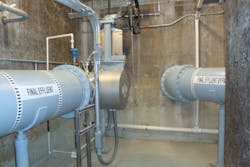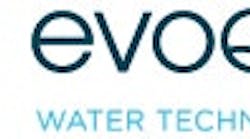The city of Rushville is located in rural Indiana, just southeast of Indianapolis. The city utility was in violation of the Clean Water Act because it was forced to bypass untreated wastewater, which would discharge into the Flat Rock River.
The city was experiencing combined sewer overflows (CSOs), which occur when a city’s wastewater and storm water drain into the same treatment system. Because the infrastructure was not originally designed to treat storm water in addition to wastewater, the flow exceeded the hydraulic capacity of the wastewater treatment plant (WWTP) or collection system. The overflow often is discharged to a receiving body of water. The city is not alone—approximately 120 communities in Indiana are susceptible to CSOs.
The overflow often combines a variable mixture of untreated human and industrial waste, polluted runoff, debris and scoured materials that build up in the collection system during dry-weather periods. Discharge contains a variety of contaminants—such as chemicals, pathogenic microorganisms, viruses and cysts—that impair water quality and impact human health and wildlife. These are the leading sources of water pollution in the U.S. In addition, as communities grow, so does the number of sidewalks, streets, parking lots and roofs—impermeable surfaces that increase the amount of runoff entering the storm water system.
An agreed order was signed in 2018 by the city of Rushville. The Indiana Department of Environmental Management (IDEM) would allow the city 15 years to eliminate the overflow. The city was to meet certain goals in five-year increments over the 15-year period; this is called a long-term control plan (LTCP).
Solution
Chlorination has traditionally been the method used to disinfect CSO water. However, growing awareness of the adverse environmental impacts associated with chlorine and the potential for byproduct formation has led to increasingly restrictive chlorine residual requirements. Ultraviolet (UV) disinfection is an efficient, low-cost and environmentally friendly way to disinfect water. The process is safer for operators—UV is a chemical-free process that adds nothing to the water. UV disinfection is able to inactivate pathogens such as Giardia and Cryptosporidium more efficiently; discharged wastewater with these pathogens can be dangerous for drinking water supplies and recreational water.
The city decided to replace its chlorination disinfection system with UV. Evoqua was selected to supply two closed-vessel ETS-UV disinfection systems to complete the LTCP. The UV equipment will treat the plant‘s wastewater and also respond to CSOs. Rushville‘s plan protects the Flat Rock River by providing a safe release of excess water through filtration and disinfection.
[Visit Evoqua's WWD Storefront]
ETS-UV systems were selected because of the compact design, relatively small number of components, product features and short lead time. ETS-UV SW systems are designed with a small footprint and an access hatch to eliminate flow disruptions and air pockets. This feature makes routine maintenance easier, eliminating the need to disassemble the chamber. The systems also have low-voltage automatic wipers to keep quartz sleeves and UV intensity monitors clean to reduce fouling, allowing the UV energy to penetrate the water. The system is fully automated to respond to variable flow and water quality without wasting energy.



